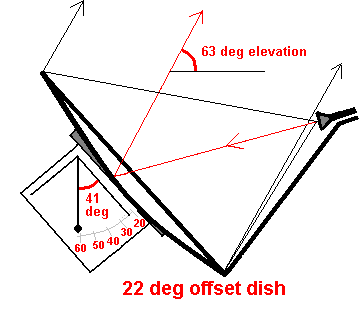|
Focal length of parabolic dish How to find offset angle of dish |
Correcting VSAT dish distortion |
Offset satellite dish elevation angle set up and pointing.
Example: A 22 degree offset angle means that the beam comes off the dish at an offset angle of 22 deg. With the front of the satellite dish vertical and feed at the lower edge, this means that the beam comes off the dish at a 22 deg angle upwards from the horizon. So, with the feed arm at the bottom, if the front face of the dish reflector itself is vertical, the beam elevation angle is 22 deg upwards. For elevation angles lower than 22 deg the front face of the dish must be tilted forwards and downwards. For elevation angles higher than 22 deg you need to tilt the top edge of the dish backwards. A backward tilt of 68 deg would make the elevation angle 90 deg., (22 + 68 = 90), with the beam going straight upwards.
Different manufacturers make dishes with a variety of offset angles. This page just uses 22 deg as example.
For very low elevation angles the lower edge of the dish and the back end of the feed support arm may meet up with the mount pole. In such cases it is necessary to mount the dish upside down with the feed arm at the top. This way you can set zero elevation angle by tipping the front face of the dish 22 deg backwards - which is applicable if you want to use the dish for terrestrial purposes. If the dish is upside down and the front face of the dish reflector itself is vertical, the beam elevation angle is -22 deg (i.e. downwards into the ground). A 30 deg backward tilt of the front face of the dish will give 8 deg beam elevation angle.

The figure shows a "22 deg offset type" dish.
The offset satellite dish is shown set for 63 deg beam elevation angle by tilting the dish backwards by 41 deg. This 41 deg angle may be set using an inclinometer or by using a home made inclinometer using a card as below.
A piece of rectangular cardboard has been used as an inclinometer. You make a pin hole in the top right corner of the card and then insert a string and small weight (e.g. metal nut) like a plumb bob.
Carefully draw a line parallel to the right edge and through the pin hole. Then, using a school protractor set out an angle of say: 41 deg and mark this "63 deg elevation"
If you want to make yourself an elevation angle scale you can mark the card in 5 deg increments as follows:
| Angle measured with protractor | Elevation angle marked |
|
3 8 13 18 23 28 33 38 41 43 48 |
25 30 35 40 45 50 55 60 63 65 70 |
If you put your eye behind the lower rim of the dish and look forwards just over the top of the feed horn you will be looking approximately directly towards the satellite. This is the line of the lower (black) ray trace in the image above. One interesting idea is to hold a thin strip of wood across the top of the feed horn and under the real bottom edge of the dish, where the feed support arm attaches. If you put an inclinometer on this strip of wood it will tell you the approx elevation angle of the beam. Adjust the mount till the elevation angle is as required. You may need 3 people, two to hold the wood and inclinometer and one to alter the elevation angle.
Please note that dishes come in a variety of offset angles. Some satellite dishes have an offset angle nearer 27 or 30 deg. There is no particular number. It varies according to manufacturer. Some may choose for the beam to be partially obstructed by the top of the feed horn. This has negligible effect on gain, scattering etc but slightly improves the cross polarisation performance Short focal length (strictly short F/D ratio) offset dishes have poor polarisation isolation unless very expensive mode matched feeds are used. Such mode matched feeds are supplied with Hughes HX modems, and the resulting cross-pol performance exceeds that of all regular front fed-offset dishes. The mode matching device comprised 3 slots inside a fat lump on the feed throat, next to the feed arm. The Feed throat is marked with 505 which must always be directly away from the feed arm.
|
► Page created 21 Jan 2005, last amended 9 Feb 2024 All pages on this satsig.net web site are Copyright SSL © 2005 all rights reserved. |